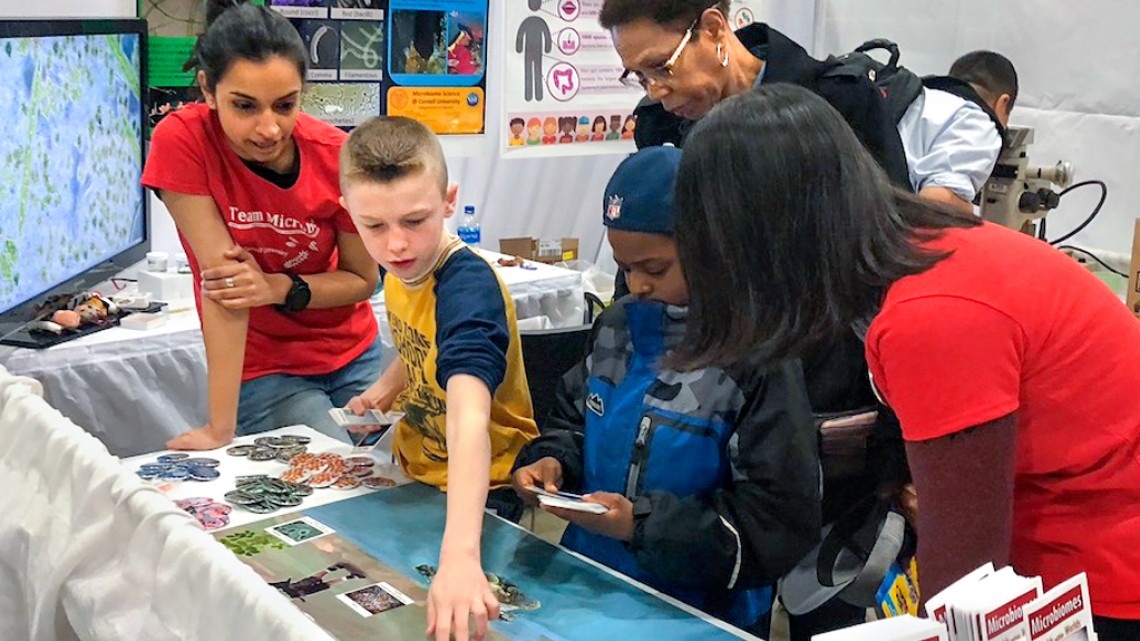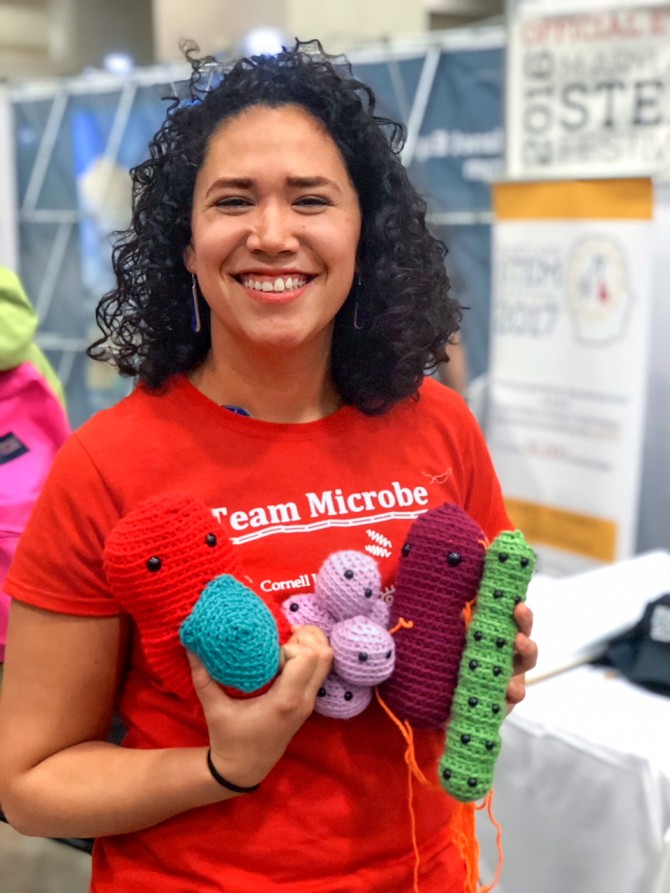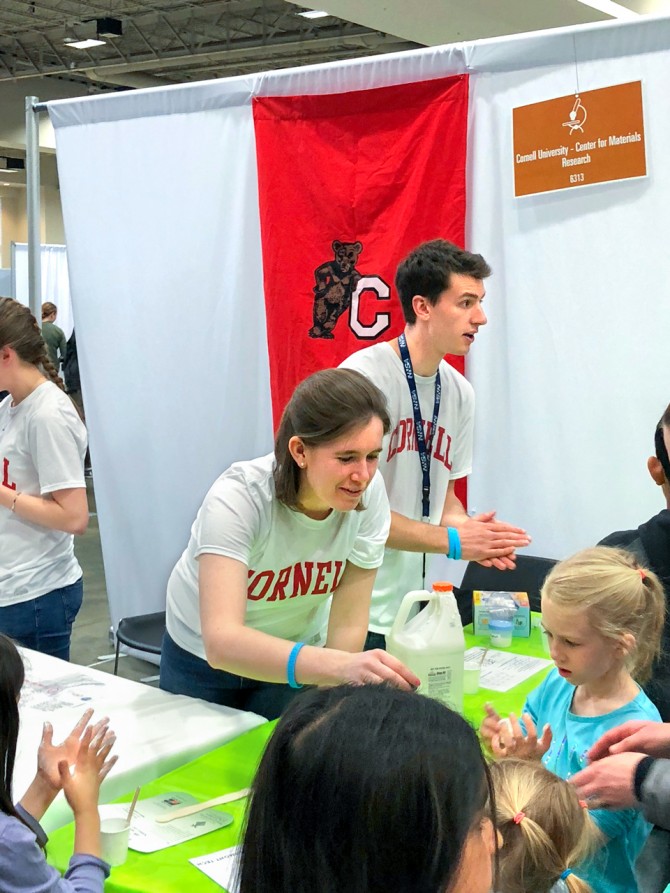
Janani Hariharan, left, and Xieyue Xiao help attendees play a game based on microbe characteristics at the USA Science and Engineering Festival.
Materials, microbiomes displayed at D.C. STEM event
By Rachel Rhodes
Scientists from the Cornell Center for Materials Research (CCMR), School of Integrative Plant Science (SIPS), the Cornell NanoScale Facility (CNF), the Department of Microbiology and the Meinig School of Biomedical Engineering represented Cornell at the annual USA Science and Engineering Festival in Washington, D.C., April 7-8.
The festival, which attracts more than 350,000 people each year, features speakers and activities designed to spark interest in STEM (science, technology, engineering, math) fields such as aviation, chemistry, natural science, sustainability and computer science.
CCMR’s display focused on teaching festival-goers about polymers. Mark Walsh, an extension support specialist with CCMR, said that as a National Science Foundation grant recipient, part of CCMR’s mission is STEM education and outreach.
“This year we are talking to kids about polymers and demonstrating the science by making Silly Putty,” he said. “We’re also giving it a twist by providing participants the option to make the Silly Putty glow in the dark, and talk about the chemistry behind making materials fluoresce.”
Walsh was joined by Aran Hubbell, Bryce Lipinski and Lilliana Morris, Cornell doctoral students in chemistry and chemical biology. For Hubbell and Morris, participating in the festival gave them the opportunity to pass on a passion for science.
“The best part of the weekend was seeing the kids’ faces light up while learning about polymers and fluorescence,” Hubbell said. “Hopefully, we are inspiring the next generation of polymer chemists.”
“There were two moments that stood out to me,” Morris said “The first was with a toddler who wasn’t old enough yet to talk, but had a look of pure joy when he played with Silly Putty for the first time. The second was when I told an older kid who stopped by our booth that I got to study polymers all the time, and he said, ‘You can do that?’ I like doing outreach because it lets me show kids and parents how cool, accessible and not scary science can be.”
CNF participated as part of the National Nanotechnology Coordinated Infrastructure, a network of 16 university nanotechnology facilities. CNF was represented by Lynn Rathbun and Beth Rhoades, who used video microscopes for the students to explore the "microworld" at 50x magnification and distributed thousands of copies of Nanooze, CNF's science magazine for kids.
Daniel Buckley, professor of microbial ecology and genomics in SIPS, led a team of 10 Cornell researchers in developing a display highlighting the importance of the microbial world. The display, Microbiome Science @ Cornell University, allowed attendees to learn about microbes, view microorganisms through a microscope and play a game with the objective of guessing where various microbes live in the world – such as in water, air or in our gut.
“The Microbiome Science @ Cornell outreach project originated through work with the National Science Foundation,” Buckley said. “We wanted to expand outreach that we’ve been doing to educate high school students about microbes, and participating in the USA Science and Engineering Festival is an impactful way to use the resources we’ve already developed to reach a wider and more diverse range of people.”
Also participating in the display were Tory Hendry, assistant professor of microbiology; postdoctoral associates Lydia Baker, Ana Maria Porras, Mel Smee and Roli Wilhelm; and doctoral students Samuel Barnett, Janani Hariharan, Cassi Wattenburger and Xieyue Xiao.
Porras said teaching young children about microbes for the first time was the most rewarding part of the experience.
“Being here is exciting,” Porras said. “Some of the smaller kids don’t know what microbes are and it is exhilarating to be here as they’re looking at microbes for the first time under the microscope.”
“One of the things we hear from parents at our booth is, ‘See, this is why you need to wash your hands,’ and that gives us an opportunity to say that actually most microbes are good. … and the world can’t work without them,” Buckley said.
Cornell groups at the festival reported more than 5,000 participants in total over the weekend, allowing scientists to meet and interact with students from across the country of all ages and experience. As Buckley noted, “Being here in D.C. gives us the opportunity to engage with diverse groups of people who are all science cheerleaders – ranging from little kids to school groups to educators.”
Rachel Rhodes is a public affairs and media relations specialist in Cornell’s Washington, D.C. office.
Media Contact
Get Cornell news delivered right to your inbox.
Subscribe


